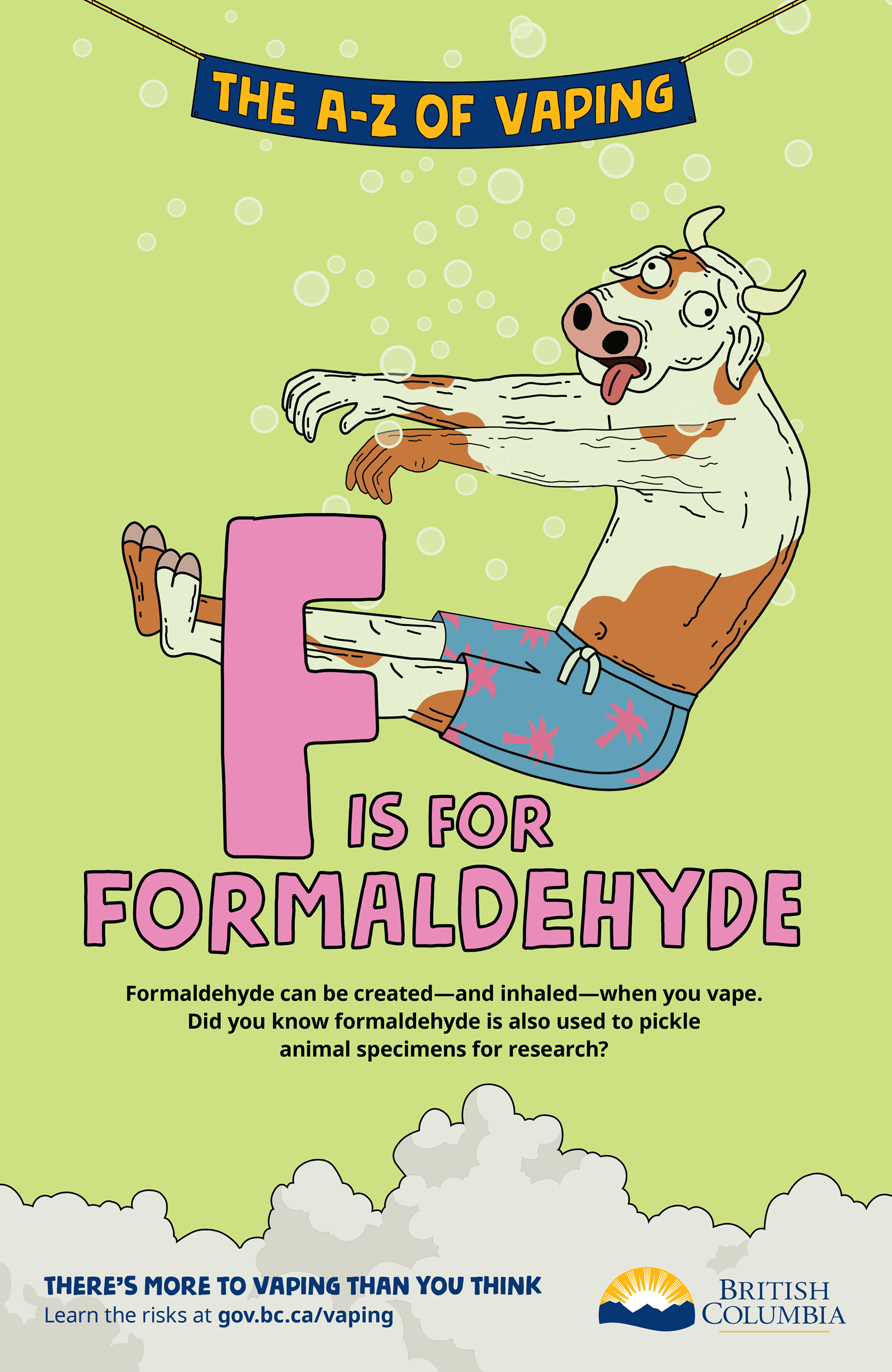New provincial anti-vaping campaign educates on the ‘A-Z of vaping’
 A new campaign aimed at raising awareness with teens and youth about the effects of vaping has been launched by the B.C. Ministry of Health.
A new campaign aimed at raising awareness with teens and youth about the effects of vaping has been launched by the B.C. Ministry of Health.
Called ‘The A-Z of vaping’ the new campaign focuses on the various chemicals that can be found in vape products and how they can affect mental and physical health. There are videos, posters, brochures and other resources available.
From carcinogens like formaldehyde and pulegone to heavy metals like arsenic and lead, the chemicals in vaping liquids can vary from manufacturer to manufacturer and have serious negative impacts on physical and mental health. Such effects can include increasing addictive behaviour, exacerbating feelings of anxiety or depression and reducing concentration.
According to a recent federal survey, Canadian teens have some of the highest vaping rates in the world, with 41 per cent of students in Grades 10 to 12 having tried vaping.
It’s something Surrey Schools substance use liaison Colette Lees attributes to the misconception that vaping is less harmful than traditional substances like tobacco or marijuana.
“Students seem to look at vaping as less harmful because it doesn’t smell bad and you don’t necessarily have that history like smoking does where we saw generations of people suffering long-term health problems,” said Lees.
Despite limited data on vaping’s long-term effects due to it being a relatively new technology, Lees has already seen her fair share of negative health effects.
“We see it in students who may have been athletes, they can’t compete or take part in the activities they used to because of how vaping may have affected them,” she said. “Academically, we’ve also seen students begin to lose interest or find it harder to focus and they sometimes will just outright give up on a class because they feel they’ve fallen too far behind.”
A key factor, said Lees, is that the majority of vaping products contain nicotine, but are delivered in a form designed to appeal to youth.
“They are often fruit or candy flavoured,” she said. “Peach mist is one I’ve seen passed around recently and so for youth who may not necessarily want to try smoking because it smells bad, a fruit-flavoured vape that is easy to hide is a lot more appealing.”
Vaping products can be especially harmful for youth as nicotine can affect the brain’s development and lead to reduced impulse control as well as long-term cognitive and behavioural problems.
Lees said the best way parents can get ahead of vaping becoming a problem for their child is having open and consistent dialogue about substances from an early age. She recommends conversations start in the latter years of elementary school, before they start secondary school.
“Just start putting out feeler questions about vaping, ask your child if they’ve heard about it, what they know about it, that kind of thing,” said Lees. “Once they get to secondary school, it may become very visible to them and so it’s important to have those talks with them before they get in a situation where they might be offered or tempted to try it.”
To explore the ‘A-Z of Vaping’, including guides and resources on how to talk to youth about vaping, click here.
For families seeking more support and resources, there are also a host of vaping resources available through Surrey Schools, the province and the BC Lung Foundation:
School district resources
Safe Schools and Fraser Health have developed a one-page vaping information sheet, available in multiple languages (Arabic, Simplified Chinese, Traditional Chinese, Punjabi, Spanish, Vietnamese), as well as a parent brochure.
The district continues to support work on vaping-related concerns through:
- The Substance Use Liaison program, providing immediate information and one-on-one substance use support for youth caught vaping in schools.
- School-based prevention presentations on the harms of vaping.
- Confiscation of vaping devices: the district has created a partnership with Quantum Lifecycle Partners LP for safe recycling of devices. Since January 2022, more than 3,000 vaping devices have been recycling, weighing more than 82 lbs. in total.
- Signage at schools regarding vaping policies, particularly at doors and washrooms.
- Increased monitoring of vaping-related zones of concerns, such as washrooms.
- Exploration of vaping-related monitoring devices for schools.
- Development of parent tools for information regarding vaping.
B.C. government resources
The provincial government has prepared a number of articles on vaping, including:
- What is vaping?
- Talking to teens about vaping
- Youth supports to quit or cut back
- Health info for youth
- Health info for adults
- Tools for schools
- Vaping and quitting smoking
- Vaping related illness
- Laws and regulations
Website: Vaping Information in B.C.
BC Lung Foundation resources
In partnership with Fraser Health, the BC Lung Foundation has developed several Vaping Health Education Toolkits in an effort to raise awareness and increase knowledge about vaping for parents and teachers, as well as to help guide youth toward making informed decisions.
These toolkits include PowerPoint presentations with integrated interactive activities and concise video content on the known health risks of vaping. They are available in English, Chinese, Punjabi, Farsi, Tagalog and Vietnamese.
- Vaping: An Overview – General information about vaping for parents, caregivers and teachers.
- Clearing the Cloud (for Grades 5-7)
- Exploring the Cloud (for Grades 8-10)

